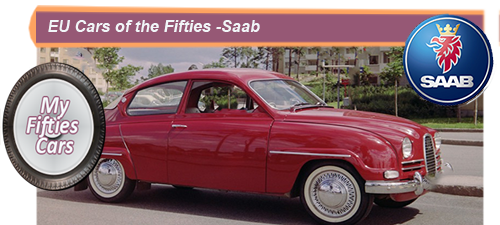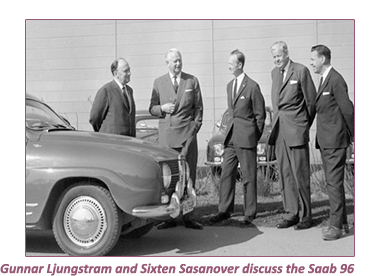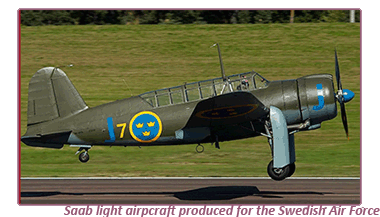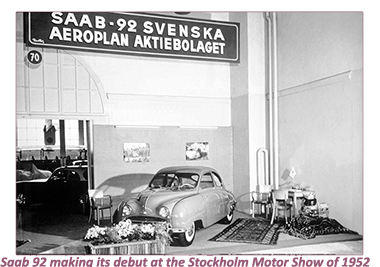
Saab (Svenska Aeroplan AB) were founded in in 1937 with the initial intention of building fighter aircraft for the Swedish Air Force. The decision to establish an independent manufacturing unit for fighter aircraft came originally from the Swedish Government, concerned by the prevailing political situation in Europe.
Invited to form Svenska Aeroplan AB) to produce these aircraft on behalf of the Swedish Government were Svenska Aero AB (SAAB). Saab were first established in 1921 to build commercial aeroplanes in conjunction with VASJA a subsidiary of the Swedish Railway Workshops. In 1938, Saab began to produce their first aircraft, mostly bombers, in the new plant situated in the city of Trollhattan, in the West of Sweden, Production got underway in 1937.
In 1938, Saab began to produce their first aircraft, mostly bombers, in the new plant situated in the city of Trollhattan, in the West of Sweden, Production got underway in 1937.
 With hostilities over, more than three hundred Saab military aircraft had been produced although most remained in mothballs throughout the conflict.
Despite their lack of combat action, Saab Aircraft had been the subject of much professional praise, and have since become internationally regarded as well as forming the backbone of the Swedish Air Force.
As was the case after World War Two, most of the World’s aircraft manufacturers, or at least whose plants had remained undamaged during the conflict, found themselves with massive production facilities that were underemployed.
With hostilities over, more than three hundred Saab military aircraft had been produced although most remained in mothballs throughout the conflict.
Despite their lack of combat action, Saab Aircraft had been the subject of much professional praise, and have since become internationally regarded as well as forming the backbone of the Swedish Air Force.
As was the case after World War Two, most of the World’s aircraft manufacturers, or at least whose plants had remained undamaged during the conflict, found themselves with massive production facilities that were underemployed.
![]()
 This is certainly the scenario that developed Saab, and like their counterparts in the UK, Bristol, the decision was made to move into producing cars, as the company were interested in maintaining employment for their highly trained and skilled personnel.
The first problem that Saab’s new car division had to confront was how to design a commercially attractive vehicle, as Sweden, if not all of Scandinavia, was not blessed with a lot of options as far as finding designers were concerned.
This is certainly the scenario that developed Saab, and like their counterparts in the UK, Bristol, the decision was made to move into producing cars, as the company were interested in maintaining employment for their highly trained and skilled personnel.
The first problem that Saab’s new car division had to confront was how to design a commercially attractive vehicle, as Sweden, if not all of Scandinavia, was not blessed with a lot of options as far as finding designers were concerned.
To overcome this obstacle the company pulled in their two most talented aeronautical and aerodynamic specialists, Gunnar Ljungstrom and Sixten Sasanover.
Ljungstrom and Sasanover set to the task of designing the first Saab with gusto, employing all of the methods they had used in developing aircraft, including producing full-size clay and wooden models, which were tested for their aerodynamic properties in the plant’s massive wind tunnel. By the time the first Saab was revealed in June of 1947, the prototypes had collectively covered more than 100,000 kilometers, ( 60,000 miles) some of them in the most testing of conditions.
The first Saab, the 92, was powered by a transversely mounted, front wheel drive twin-cylinder two-stroke engine. Response to the Saab 92 was positive, even when Saab dampened the enthusiasm of potential buyers when they announced that the first models would not be available for sale until December 1949.
That piece of news did not deter major Swedish car distributor Philipson’s Automobil AB who placed an order for no less than 8,000 Saab 92s and even paid a substantial advance on their order to help the new company’s cash flow.
By the time the first Saab was revealed in June of 1947, the prototypes had collectively covered more than 100,000 kilometers, ( 60,000 miles) some of them in the most testing of conditions.
The first Saab, the 92, was powered by a transversely mounted, front wheel drive twin-cylinder two-stroke engine. Response to the Saab 92 was positive, even when Saab dampened the enthusiasm of potential buyers when they announced that the first models would not be available for sale until December 1949.
That piece of news did not deter major Swedish car distributor Philipson’s Automobil AB who placed an order for no less than 8,000 Saab 92s and even paid a substantial advance on their order to help the new company’s cash flow.
![]()
As production got underway, Saab was soon to discover that establishing a car factory from scratch was no easy task, with the division hit by a seemingly endless stream of “teething problems."
At one point, production was so slow that the massive production plant was producing just four units daily. The situation was not made any easier with constant shortages of raw materials meaning that the new Saabs were coming off the production line painted a deep and unattractive shade of khaki green. Once again the owners of Philipson displayed great flexibility, virtually agreeing to wait what for whatever time it took for Saab to complete their order.
The reason for their flexibility might well have been as a result of the extremely positive feedback from owners who already taken delivery of their new Saab 92 and had rapidly discovered their new cars were incredibly suitable for driving through the deep snow and the underdeveloped roads that crisscrossed the Swedish countryside.
The Swedish car buying public, few and far between in these days, were aware of the challenges and difficulties that driving would bring and were encouraged by the Saab’s almost entirely smooth floor pan which allowed the car to effortlessly glide over snow and slush instead of having to plough through it.
By the end of 1952, three years behind on their delivery schedule, Saab had completed just 5,300 92s, even taking time to give the car a design update and increase the range of colours that it came in.
Once again the owners of Philipson displayed great flexibility, virtually agreeing to wait what for whatever time it took for Saab to complete their order.
The reason for their flexibility might well have been as a result of the extremely positive feedback from owners who already taken delivery of their new Saab 92 and had rapidly discovered their new cars were incredibly suitable for driving through the deep snow and the underdeveloped roads that crisscrossed the Swedish countryside.
The Swedish car buying public, few and far between in these days, were aware of the challenges and difficulties that driving would bring and were encouraged by the Saab’s almost entirely smooth floor pan which allowed the car to effortlessly glide over snow and slush instead of having to plough through it.
By the end of 1952, three years behind on their delivery schedule, Saab had completed just 5,300 92s, even taking time to give the car a design update and increase the range of colours that it came in.
 Having played a major part in putting Saab on the map, the 92 was discontinued in summer of 1955, with the 93 coming in its place.
Having played a major part in putting Saab on the map, the 92 was discontinued in summer of 1955, with the 93 coming in its place.
History of the great UK and European cars of the Fifties and Sixties, the people that produced them as well as tips omnhow to acquire, restore and maintain a classic car.
Got a question, a comment, a suggestion or an offer??? - FEEL FREE TO CONTACT US ANYTIME!!
Take me back to the home page
